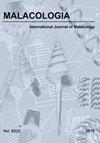拉曼光谱和扫描电子显微镜揭示了蚯蚓粪中生物矿化过程的证据
IF 1
4区 生物学
Q4 ZOOLOGY
引用次数: 1
摘要
摘要:利用分析(拉曼光谱)和成像(扫描电子显微镜)方法,我们证明了郁金香Eualetes tulipa和变种Petalonchus varians的踏板粘液中存在生物矿化过程。拉曼光谱显示,v1(CO)1085、n4(OCO)717和705cm-1附近存在主要谱带,这归因于结晶为方解石和霰石的碳酸钙的拉伸模式。SEM图像显示粘液中存在文石针和方解石的菱形晶体。在E.tulipa和P.varians的饲养粘液中,碳酸钙前体的二次成核是碳酸钙晶体形成和生长的最可能途径。维美德的管状外壳可塑性很强。它们能够不断改变外壳孔径的方向,重塑管道并构建终端结构。因此,vermetid外壳可以充当探测管,让蜗牛从更好的水流中获利,避开障碍,成功争夺空间。这种可塑性可能需要额外的碳酸钙供应,尤其是在涉及不确定生长的情况下,如Eualetes和Petalonchus物种的情况;这将解释进食粘液中生物成因碳酸钙形成的功能意义。本文章由计算机程序翻译,如有差异,请以英文原文为准。
Evidence of a Biogenic Mineralization Process in Vermetid Feeding Mucus as Revealed by Raman Spectroscopy and Scanning Electron Microscopy
ABSTRACT Using analytical (Raman spectroscopy) and imaging (scanning electron microscopy) approaches, we evidenced a biogenic mineralization process in the pedal mucus of the vermetids Eualetes tulipa and Petaloconchus varians. Raman spectra showed the presence of main bands around v1(CO) 1,085, n4(OCO) 717 and 705 cm-1 attributed to stretching modes of calcium carbonate crystallized as calcite and aragonite. SEM images showed the presence of aragonite needles and rhombohedral crystals of calcite in the mucus. Secondary nucleation from calcium carbonate precursors is the most probably pathway for the formation and growth of calcium carbonate crystals in feeding mucus of E. tulipa and P. varians. The tube-like shells of vermetids are very plastic. They are capable of continuously modify the direction of the shell aperture, remolding their tubes and building terminal structures. As a result, vermetid shells may act as exploratory tubes that allow the snail to profit from a better water flow, avoid obstacles and successfully compete for space. Such plasticity probably demands an extra supply of calcium carbonate, particularly when indeterminate growth is involved, as is the case for species of Eualetes and Petaloconchus; this would explain the functional significance of the biogenic calcium carbonate formation in the feeding mucus.
求助全文
通过发布文献求助,成功后即可免费获取论文全文。
去求助
来源期刊

Malacologia
生物-动物学
CiteScore
2.00
自引率
0.00%
发文量
15
审稿时长
3 months
期刊介绍:
Malacologia publishes papers on all groups of the Mollusca. Malacologia specializes in publishing long papers and monographic treatments. Complete data are especially appreciated. Papers must be of interest to an international readership. Papers in systematics, ecology, population ecology, genetics, molecular genetics, evolution and phylogenetic treatments are especially welcomed. Also welcomed are letters to the editor involving papers published or issues of import to science of the day.
 求助内容:
求助内容: 应助结果提醒方式:
应助结果提醒方式:


